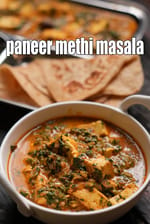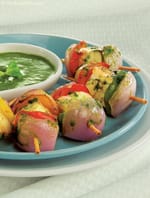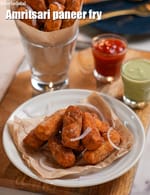Homemade paneer using full fat milk | Traditional Full-Fat Paneer | Rich & Fresh Paneer (from Scratch) | Classic Indian Homemade Paneer |
Table of Content
|
About Paneer
|
|
Ingredients
|
|
Methods
|
|
Other recipes with homemade Paneer
|
|
Health benefits of Paneer
|
|
To make homemade paneer recipe
|
|
Tips for storing Paneer
|
|
How to make Paneer using a mould
|
|
Nutrient values
|
Homemade paneer using full fat milk | Traditional Full-Fat Paneer | Rich & Fresh Paneer (from Scratch) | Classic Indian Homemade Paneer | with 15 amazing images.
Homemade paneer, made from full-fat milk, is a culinary delight in Indian cuisine. This fresh, unaged cheese is remarkably simple to prepare at home and offers a superior taste and texture compared to its store-bought counterparts. Using full-fat milk is key to achieving that rich, creamy texture and vibrant flavor that makes homemade paneer so desirable. It's a versatile ingredient that forms the backbone of countless Indian dishes, from rich curries to savory snacks and even some desserts.
The process of making paneer begins by bringing 2 liters of full-fat milk to a boil in a large pan, stirring occasionally to prevent scorching. Once the milk starts boiling, the heat is turned off, and it's allowed to rest for just one minute. This brief resting period is important as it allows the milk to cool slightly, ensuring a softer curdling process and a more tender paneer. Without this pause, adding the acid to very hot milk can result in a rubbery texture.
The magic of curdling happens with the gradual addition of 2 tablespoons of lemon juice. This is added slowly while gently stirring the milk. Lemon juice, a natural acid, reacts with the milk proteins, causing them to coagulate and separate from the watery whey. It's crucial to stir gently and not vigorously, as harsh stirring can break up the curds too much, leading to a grainy paneer. After adding the lemon juice, the mixture is allowed to stand for about half a minute, during which the milk clearly curdles, and the greenish-yellow whey completely separates.
Once the milk has fully curdled, the next step is to strain the solids (the crumbled paneer) using a clean, damp muslin cloth. All the whey is carefully drained out. If you desire a firmer, solid block of paneer for cutting into cubes, the crumbled paneer in the muslin cloth is then placed into a paneer mold (or any suitable mold like a colander) and pressed. Applying approximately 1 kg of weight on top of the paneer for about an hour helps to compress it and drain any remaining whey, resulting in a firm block.
After the pressing period, the paneer is carefully removed from the muslin cloth. It can then be cut into even-sized cubes or grated, depending on its intended use in a recipe. This homemade paneer is incredibly fresh and is best used immediately to retain its optimal texture and flavor. The process yields about 2 cups of fresh paneer, providing a wholesome and delicious ingredient ready to be transformed into various culinary creations.
Homemade paneer made from full-fat milk offers a superior product for its freshness, taste, and texture. While the recipe uses full-fat milk, the paneer itself is a rich source of protein and calcium, making it a valuable addition to many diets. It provides a satisfying mouthfeel and acts as a versatile canvas for absorbing the flavors of spices and gravies in Indian dishes, showcasing the simplicity and effectiveness of traditional Indian dairy preparations.
Enjoy Homemade paneer using full fat milk | Traditional Full-Fat Paneer | Rich & Fresh Paneer (from Scratch) | Classic Indian Homemade Paneer | with step by step photos.
Tags
Soaking Time
0
Preparation Time
5 Mins
Cooking Time
16 Mins
Baking Time
0 Mins
Baking Temperature
0
Sprouting Time
0
Total Time
21 Mins
Makes
2 cups paneer cubes
Ingredients
For Paneer
- 2 ltrs full-fat milk
- 2 tbsp lemon juice
Method
For paneer
- To make the paneer, put the milk to boil in a large pan, while stirring occasionally.
- When it starts boiling, switch off the flame and wait for 1 minute.
- Add the lemon juice gradually, while stirring gently and wait for 2 minutes.
- Once the milk has curdled, strain using a muslin cloth. This is crumbled paneer.
- If you want solid paneer, place the paneer into the muslin cloth in a 125 mm. (5”) paneer mould or any mould. Press it with a lid. Alternatively, use a colander and put the paneer (along with the muslin cloth) into it. Put approx. 1 kg of weight on a plate and place this over the paneer.
- Remove the paneer from the muslin cloth and after 1 hour, cut into even sized cubes or grate it and use as required.
Handy tip:
- To store paneer, place it in enough water in an air-tight container and keep refrigerated.
Homemade paneer using full fat milk | Traditional Full-Fat Paneer | Rich & Fresh Paneer (from Scratch) | Classic Indian Homemade Paneer | Video by Tarla Dalal
Paneer recipe with step by step photos
-
- Paneer or cottage cheese is an Indian soft cheese which is used to make an array of recipes ranging from starters, main course, desserts to accompaniments. If you like this Homemade Paneer recipe, you can also try out other recipes using Paneer from our website:
- The recipe provided below is made using full fat milk. but, there are many ways to make paneer. Here are some other paneer recipes for reference purpose :
-
- Paneer or cottage cheese is rich in healthy nutrients like calcium and vitamin D. It is a good source of vitamin A and minerals like iron, calcium, magnesium, phosphorus, sodium, potassium and zinc. It is rich in omega-3 fatty acids and omega-6 fatty acids which help in fighting and preventing rheumatoid arthritis and other bone problems. Paneer must be included in growing children’s diet at least once or twice week. (Adults with hypertension and heart diseases should avoid Paneer because it has a high sodium content and is also high in calories.) Read more about the health benefits of Paneer.
- It is rich in omega-3 fatty acids and omega-6 fatty acids which help in fighting and preventing rheumatoid arthritis and other bone problems. Paneer must be included in growing children’s diet at least once or twice week. (Adults with hypertension and heart diseases should avoid Paneer because it has a high sodium content and is also high in calories.) Read more about the health benefits of Paneer.
-
-
To make the homemade paneer recipe, rinse a deep non-stick pan with ¼ cup of water and quickly simmer it for 2-3 minutes. This will prevent milk from scorching as the water forms a protective layer between the pan and milk. This is generally done in stainless steel pans but, if you have an old non-stick pan it is advisable to make this extra effort so that the milk does not burn.
-1-185696.webp?w=800&format=webp)
-
Rotate the pan in a clockwise motion, so the water spreads evenly in the pan. Discard the water and pour 2 liters of full fat-milk. Full fat milk is highly recommended while making paneer as it yields more chenna after curdling resulting into a thick block of paneer.
-2-185696.webp?w=800&format=webp)
-
Bring it to a boil on a medium high flame. This would take around 8-10 minutes.
-3-185696.webp?w=800&format=webp)
-
Stir it occasionally to avoid milk from sticking to the bottom of the pan or browning. It is always better to use a wooden flat spoon because
- It doesn’t get heated up easily.
- If u place it horizontally over the vessel in such a way that it touches 2 opposite edges, it will prevent the milk from falling off the edges of the pan after the milk is boiled.
-
While the milk is boiling, we will assemble the strainer. Take a bowl and place a strainer on top of it.
-5-185696.webp?w=800&format=webp)
-
Arrange a muslin cloth or clean cheesecloth, thin napkin over it. Keep aside.
-6-185696.webp?w=800&format=webp)
-
When it starts boiling, switch off the flame and wait for 1 minute. The milk should be boiling hot before you add the acidic substance to speed up the process of curdling and to prevent the Paneer from becoming grainy.
-7-185696.webp?w=800&format=webp)
-
Add the lemon juice gradually, while stirring gently and wait for 2 minutes. Always add the acid (lemon juice or vinegar) only after the milk has boiled completely.
-8-185696.webp?w=800&format=webp)
-
Stir the milk and check if the milk has curdled completely.
-9-185696.webp?w=800&format=webp)
- If the milk has not begun to curdle, add more acid. But, if you add too much of acid the Paneer will become tough. The quantity of the acidic agent is purely judgemental . You can even make paneer recipe at home by curdling full-fat milk using Yogurt, Buttermilk or Citric Acid.
-
Let it stand for a few seconds. Once the milk has curdled completely, it will look like this. The greenish watery whey has separated.
-11-185696.webp?w=800&format=webp)
-
Strain using a clean muslin cloth. You can add a few ice cubes so that the process of curdling stops quickly and the Paneer is not grainy or tough.
-12-185696.webp?w=800&format=webp)
-
Fold all the 4 sides of the muslin cloth and twirl it gently so that all the whey that is in the milk solids gets evenly drained out. Homemade paneer turns soft when the curdled milk is not boiled further. Overcooking will result into hard and chewy paneer.
-13-185696.webp?w=800&format=webp)
-
Wash it under running water. It is very important to wash the curdled milk properly to remove the acidic traces while preparing paneer at home.
-14-185696.webp?w=800&format=webp)
-
Or you can even place the muslin cloth with the chenna in a bowl of fresh water and wash it 2 to 3 times.
-15-185696.webp?w=800&format=webp)
-
The crumbled paneer which we have right now is also known as chenna in the eastern parts of India and is the precursor of many traditional Indian mithais like Rasogulla, Chenna payesh, Rasmalai, etc.
-16-185696.webp?w=800&format=webp)
-
The discarded whey water can be used to make whey soup which is a rich source of protein.
-17-185696.webp?w=800&format=webp)
-
Give a proper shape to the paneer with your hand.
-18-185696.webp?w=800&format=webp)
- Fold it from right and left side.
-
Now, fold it from top and bottom portion. Press it lightly.
-20-185696.webp?w=800&format=webp)
-
Take a bowl and place the colander over it.
-21-185696.webp?w=800&format=webp)
-
Place the shaped paneer over it.
-22-185696.webp?w=800&format=webp)
-
Put a plate over it. The plate is kept so that the weight is evenly distributed.
-23-185696.webp?w=800&format=webp)
-
If you feel that your Chenna is too soft or if you want to speed up the process you can put some weight(about 1 kg) on top of the lid. Keeping too much weight will make the paneer dense and rubbery. Alternatively, you can even, place the Paneer into the muslin cloth in a 125 mm. (5”) paneer mould or any mould.
-24-185696.webp?w=800&format=webp)
-
After 1 hour, the Full Fat Paneer will look like this.
-25-185696.webp?w=800&format=webp)
- Remove from the muslin cloth.
-
Place it upside down on a plate or any clean and dry surface. You will see a smooth surface on top.
-27-185696.webp?w=800&format=webp)
-
Cut the Full Fat Paneer into even sized cubes or grate it/crumble it and use as required. Avoid deep frying to prevent the paneer from becoming dry and rubbery.
-28-185696.webp?w=800&format=webp)
-
To make the homemade paneer recipe, rinse a deep non-stick pan with ¼ cup of water and quickly simmer it for 2-3 minutes. This will prevent milk from scorching as the water forms a protective layer between the pan and milk. This is generally done in stainless steel pans but, if you have an old non-stick pan it is advisable to make this extra effort so that the milk does not burn.
-
-
Homemade paneer is more hygenic, fresh. To store paneer, place it in enough water in an air-tight container and keep it refrigerated. Submerging Paneer in water will prevent it from becoming dry. Use it within 2-3 days.
-1-185697.webp?w=800&format=webp)
- Alternatively,if you store paneer directly in an air-tight container, then you can even submerge paneer in warm water after removing from the refrigerator.
-
Homemade paneer is more hygenic, fresh. To store paneer, place it in enough water in an air-tight container and keep it refrigerated. Submerging Paneer in water will prevent it from becoming dry. Use it within 2-3 days.
-
-
After step 20, take a 125 mm (5”) paneer mould or any mould and place the paneer into it. Press it with a lid and put a water filled jar or bowl on it to get the pressure.

-
Remove the paneer from the muslin cloth and after 1 to 2 hours.

-
Cut into even sized cubes or grate/crumble it. Be gentle and use a sharp knife if you are cutting the Paneer into cubes so that they dont break. Use as required.

-
After step 20, take a 125 mm (5”) paneer mould or any mould and place the paneer into it. Press it with a lid and put a water filled jar or bowl on it to get the pressure.
Nutrient values (Abbrv)per plate
| Energy | 877 cal |
| Protein | 38.5 g |
| Carbohydrates | 47.4 g |
| Fiber | 0.5 g |
| Fat | 58 g |
| Cholesterol | 142.2 mg |
| Sodium | 169.4 mg |
Click here to view Calories for Paneer
The Nutrient info is complete
Mansi Shah
July 21, 2011, 4:18 a.m.
Great to make my homemade paneer finally. Thanks.
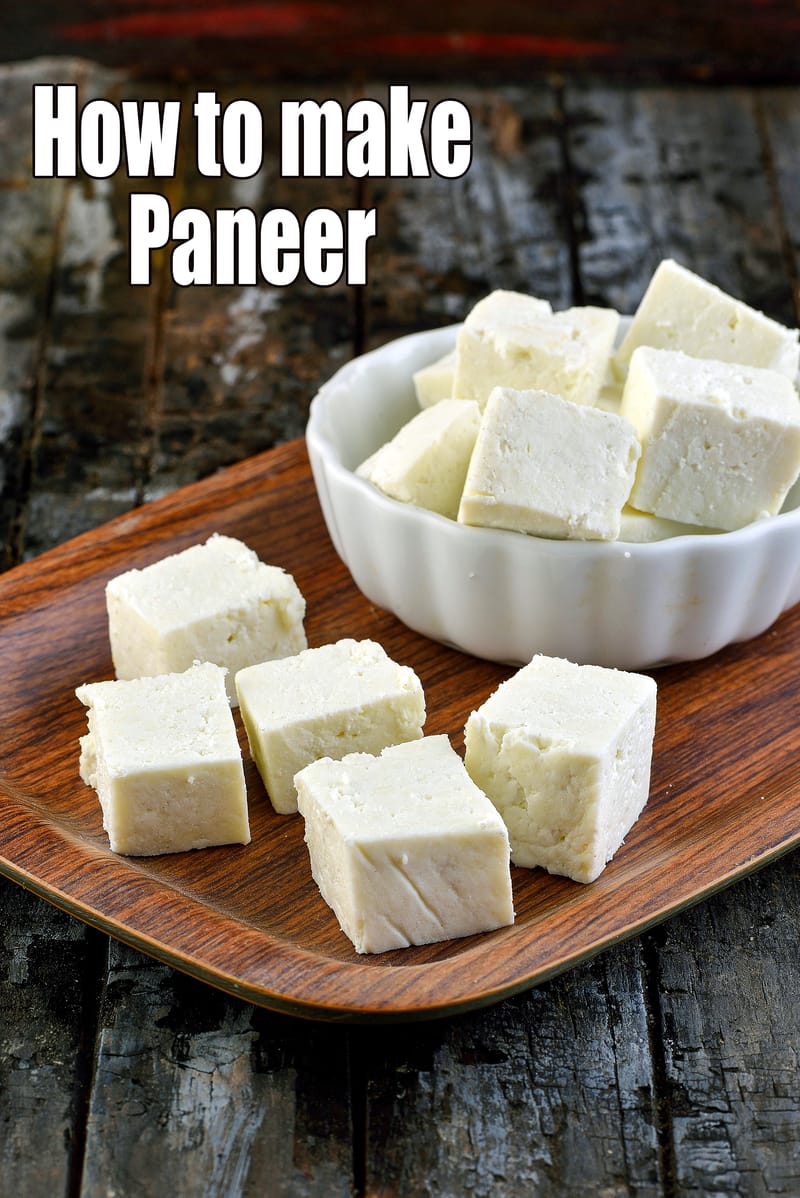


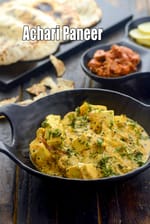
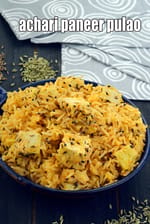

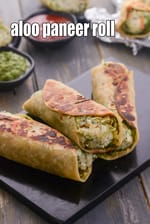
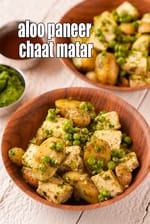

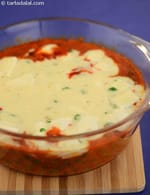
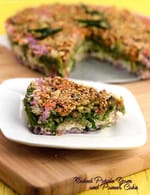
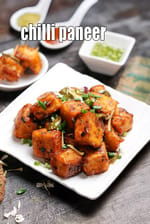
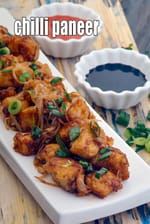

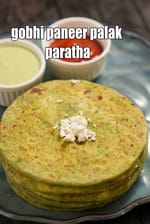
-1544.webp)
